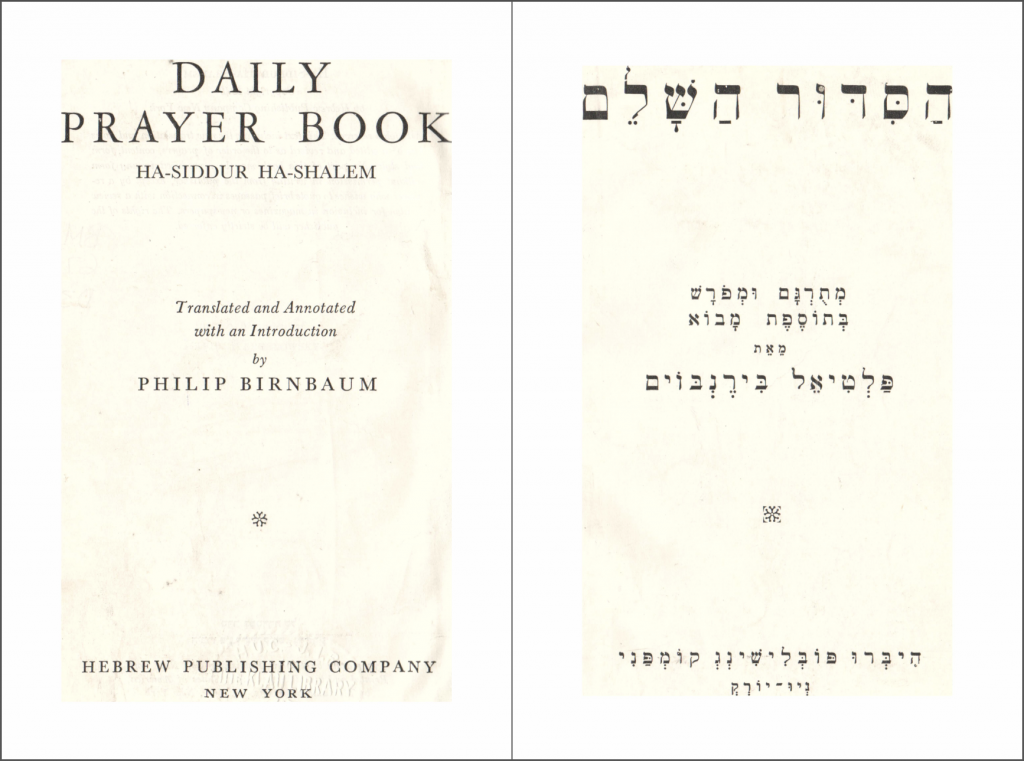
This work is in the Public Domain due to the lack of a copyright renewal by the copyright holder listed in the copyright notice (a condition required for works published in the United States between January 1st 1924 and January 1st 1964).
This work was scanned by Aharon Varady for the Open Siddur Project from a volume held in the collection of the HUC Klau Library, Cincinnati, Ohio. (Thank you!) This work is cross-posted to the Internet Archive, as a repository for our transcription efforts.
Scanning this work (making digital images of each page) is the first step in a more comprehensive project of transcribing each prayer and associating it with its translation. You are invited to participate in this collaborative transcription effort!
FOREWORD
The Passover Haggadah, reflecting Israel’s constant struggle for life and liberty, is one of the most frequently edited books. Few Hebrew classics are so famous and have attracted the attention of so many Jews as the Haggadah. Since the sixteenth century, the Haggadah has appeared in more than two thousand separate editions. Representing a gradual development, the Haggadah is not the work of any one man nor the product of any one period. Some of its contents have come down to us from ancient times; they were an essential part of the Seder service two thousand years ago. The very name Seder is borrowed from the Hebrew title of this book, Seder Haggadah, which denotes an arrangement of the varied literature that went into the composition of the Haggadah before it became the standard for all Israel.
Our people have not ceased to lavish their love on the Haggadah, the priceless midrashic collection that has stirred the spirit of freedom in the hearts of young and old through countless generations. Its purpose has been to show us the beauty of true freedom where a man is free to do his duty. Scores of scholars have written significant commentaries on this inspiring anonymous work. Its pages have often been richly ornamented with numerous paintings and drawings depicting memorable events in the history of our people.
The power of tradition is clearly demonstrated by the Seder service. Even the least observant Jews heed its ancient symbolism and its ancient forms. The night of the exodus has become a history feast par excellence. Every generation celebrating the Seder becomes united with all the generations of the people. For this reason, the rabbis of old aimed at unanimity and uniformity. It was a matter of principle with them that there should be no division in custom and observance.
The traditional Haggadah, based upon the idea that he w’ho questions much learns much, is a continuous chain linking the generations together. We have succeeded in preserving the national and religious significance of the Seder chiefly through the effective use of the indispensable Haggadah. Its subject matter is extensively quoted in talmudic literature and widely discussed by authorities like Rav Saadyah Gaon, Rashi, Maimonides, and so on. Its text is permeated with folklore, prayer and poetry. Alterations or changes, ostensibly designed to meet the needs of our own day, would eventually undermine this classical work which has been cherished through the ages.
To be sure, some passages in the traditional Haggadah are strange to those who are not acquainted with the midrashic style of our sages. These passages have at all times stimulated questions and answers and have given rise to lively discussion. The Haggadah is filled with biblical quotations and rabbinical interpretations so that every Jewish family, once a year at least, is afforded an opportunity to comply with the statement that those who discuss Torah at the table are eating at the table of God. Indeed, the Haggadah has been serving as a ready textbook furnishing material for thoughtful round-table discussions.
This edition consists of an entirely new translation combining clarity of style with accuracy, and a running commentary containing information derived from a wide range of scholarly works. Biographical sketches of sages and poets are likewise supplied in the footnotes. At the bottom of the pages are biblical references indicating the central source of the Haggadah.
The traditional Hebrew text is left intact. It is carefully vocalized, and divided into sentences and clauses by the use of modern punctuation marks. There is no variation of type sizes so as to remove every possibility of mental stumbling and interference with the proper appreciation of the Haggadah. Every effort has been made to produce an edition giving the ancient text renewed force and interest.
We are indebted to the Jewish Museum under the auspices of the Jewish Theological Seminary and to Frank J. Darmstaedter, photographer, for making the Haggadah illustrations available to us.
PHILIP BIRNBAUM
February, 1953.

“📖 סדר הגדה של פסח | Seder Haggadah Shel Pesaḥ, translated and annotated by Paltiel Birnbaum (1953)” is shared through the Open Siddur Project with a Creative Commons Public Domain Dedication 1.0 Universal license.










The Hebrew text of this Birnbaum Haggadah (1953) has been fully transcribed at Hebrew Wikisource:
https://he.wikisource.org/wiki/%D7%9E%D7%A4%D7%AA%D7%97:Birnbaum_Haggadah.pdf
Others are welcome to complete the transcription of the English text (which might be an excellent basis for an updated English translation of the Siddur) here:
https://en.wikisource.org/wiki/Index:Birnbaum_Haggadah.pdf
Best wishes to all for health and comfort.
Shabbat shalom